ExxonMobil Business Strategy Analysis
VerifiedAdded on 2023/06/11
|19
|4990
|350
AI Summary
This report analyzes ExxonMobil's business strategy including its organizational structure, innovations strategy, supply chain management, financial strength, and more. The report provides insights on strategic management and includes a SWOT analysis, VRIO analysis, and Five Forces model of Porter.
Contribute Materials
Your contribution can guide someone’s learning journey. Share your
documents today.

Running head: STRATEGIC MANAGEMENT
ExxonMobil Business Strategy Analysis
Student’s Name:
Institution:
Word Count: 3000
ExxonMobil Business Strategy Analysis
Student’s Name:
Institution:
Word Count: 3000
Secure Best Marks with AI Grader
Need help grading? Try our AI Grader for instant feedback on your assignments.
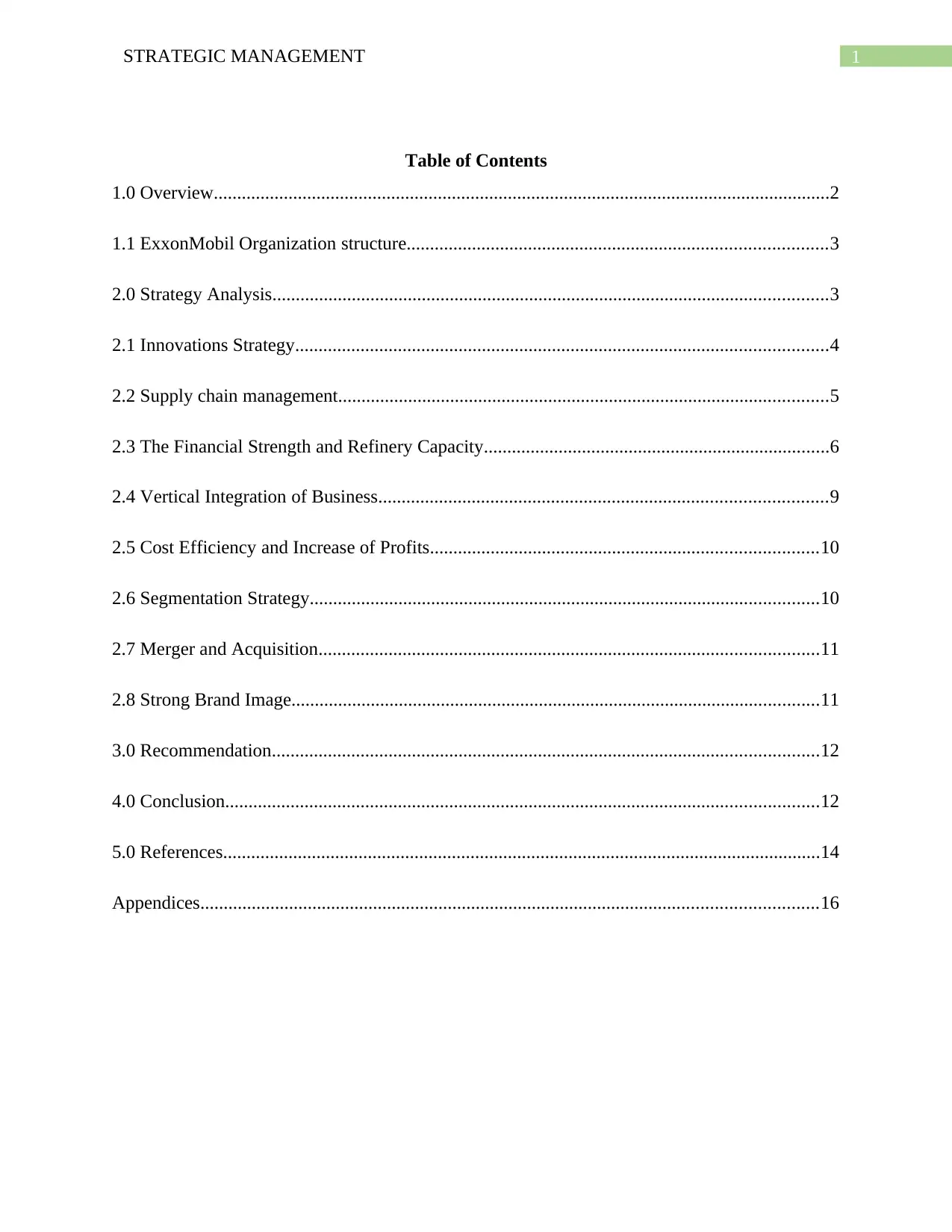
1STRATEGIC MANAGEMENT
Table of Contents
1.0 Overview....................................................................................................................................2
1.1 ExxonMobil Organization structure..........................................................................................3
2.0 Strategy Analysis.......................................................................................................................3
2.1 Innovations Strategy..................................................................................................................4
2.2 Supply chain management.........................................................................................................5
2.3 The Financial Strength and Refinery Capacity..........................................................................6
2.4 Vertical Integration of Business................................................................................................9
2.5 Cost Efficiency and Increase of Profits...................................................................................10
2.6 Segmentation Strategy.............................................................................................................10
2.7 Merger and Acquisition...........................................................................................................11
2.8 Strong Brand Image.................................................................................................................11
3.0 Recommendation.....................................................................................................................12
4.0 Conclusion...............................................................................................................................12
5.0 References................................................................................................................................14
Appendices....................................................................................................................................16
Table of Contents
1.0 Overview....................................................................................................................................2
1.1 ExxonMobil Organization structure..........................................................................................3
2.0 Strategy Analysis.......................................................................................................................3
2.1 Innovations Strategy..................................................................................................................4
2.2 Supply chain management.........................................................................................................5
2.3 The Financial Strength and Refinery Capacity..........................................................................6
2.4 Vertical Integration of Business................................................................................................9
2.5 Cost Efficiency and Increase of Profits...................................................................................10
2.6 Segmentation Strategy.............................................................................................................10
2.7 Merger and Acquisition...........................................................................................................11
2.8 Strong Brand Image.................................................................................................................11
3.0 Recommendation.....................................................................................................................12
4.0 Conclusion...............................................................................................................................12
5.0 References................................................................................................................................14
Appendices....................................................................................................................................16

2STRATEGIC MANAGEMENT
1.0 Overview
The organization is based in America and was established in 1870. It’s headquarter is
situated in Irving, Texas. The company explores and produces crude oil as well as natural gas.
The operation of the company is spread in various nations across the globe. It explores oil and
natural gas in six continents. In order to penetrate the global business arena, the organization has
segmented its operation into Chemical segments, Downstream and Upstream which make up the
ten companies that are separate from each other. Additionally, the organization manufactures
petroleum products, market petrochemicals and various products including the generation of
electricity. It also undertakes transportation and selling of crude oil, natural gas, and petroleum
products. The company has over 80,000 employees.
The organization has transformed itself from trading kerosene in America to trading
petrol and petrochemicals on a global manner. It is among the largest and is one of the top
companies in the petroleum and petrochemical sector globally. The products that they create are
the driving forces in the present transportation systems, power towns, they provide lubricants to
the industry and offer petrochemical which are the building blocks many of the consumer goods.
To deliver petrochemical products, the organization employs innovation and technology with the
aim of meeting the globe’s growing demand. They have strong human resource, technical
expertise, strong financial capabilities and a wide reach the present the company with a strong
competitive advantage. This thus allows the company to get exposed to opportunities. Moreover,
the organization has an extensive research programs that support the operation as well as
allowing continuous improvement in all the business lines as well as exploiting new as emerging
energy resources and technologies.
This report will deal with the organizational structure along with the different strategies
that has been taken up by ExxonMobil so that they can be advantageous in the market. It will
provide a brief description of the organization along with the strategies that have been taken up
by them to provide new innovations in the market. The financial strength of the company has
also been analyzed so that it can help in understanding the resources that are available to them in
making the changes in the present market. The report also contains the segmentation strategy,
which has allowed the company in segmenting its important customers in different categories
according to their needs and preferences.
1.0 Overview
The organization is based in America and was established in 1870. It’s headquarter is
situated in Irving, Texas. The company explores and produces crude oil as well as natural gas.
The operation of the company is spread in various nations across the globe. It explores oil and
natural gas in six continents. In order to penetrate the global business arena, the organization has
segmented its operation into Chemical segments, Downstream and Upstream which make up the
ten companies that are separate from each other. Additionally, the organization manufactures
petroleum products, market petrochemicals and various products including the generation of
electricity. It also undertakes transportation and selling of crude oil, natural gas, and petroleum
products. The company has over 80,000 employees.
The organization has transformed itself from trading kerosene in America to trading
petrol and petrochemicals on a global manner. It is among the largest and is one of the top
companies in the petroleum and petrochemical sector globally. The products that they create are
the driving forces in the present transportation systems, power towns, they provide lubricants to
the industry and offer petrochemical which are the building blocks many of the consumer goods.
To deliver petrochemical products, the organization employs innovation and technology with the
aim of meeting the globe’s growing demand. They have strong human resource, technical
expertise, strong financial capabilities and a wide reach the present the company with a strong
competitive advantage. This thus allows the company to get exposed to opportunities. Moreover,
the organization has an extensive research programs that support the operation as well as
allowing continuous improvement in all the business lines as well as exploiting new as emerging
energy resources and technologies.
This report will deal with the organizational structure along with the different strategies
that has been taken up by ExxonMobil so that they can be advantageous in the market. It will
provide a brief description of the organization along with the strategies that have been taken up
by them to provide new innovations in the market. The financial strength of the company has
also been analyzed so that it can help in understanding the resources that are available to them in
making the changes in the present market. The report also contains the segmentation strategy,
which has allowed the company in segmenting its important customers in different categories
according to their needs and preferences.
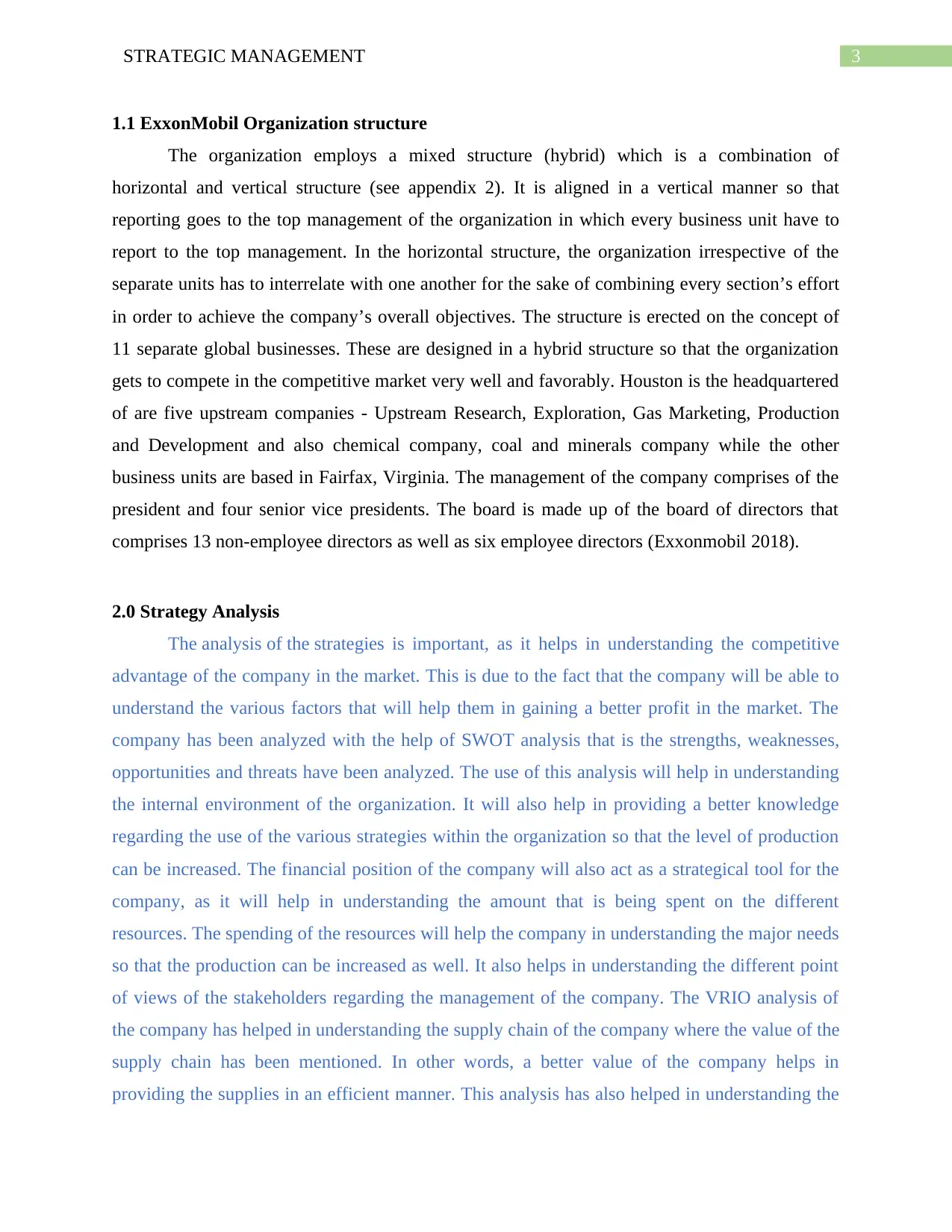
3STRATEGIC MANAGEMENT
1.1 ExxonMobil Organization structure
The organization employs a mixed structure (hybrid) which is a combination of
horizontal and vertical structure (see appendix 2). It is aligned in a vertical manner so that
reporting goes to the top management of the organization in which every business unit have to
report to the top management. In the horizontal structure, the organization irrespective of the
separate units has to interrelate with one another for the sake of combining every section’s effort
in order to achieve the company’s overall objectives. The structure is erected on the concept of
11 separate global businesses. These are designed in a hybrid structure so that the organization
gets to compete in the competitive market very well and favorably. Houston is the headquartered
of are five upstream companies - Upstream Research, Exploration, Gas Marketing, Production
and Development and also chemical company, coal and minerals company while the other
business units are based in Fairfax, Virginia. The management of the company comprises of the
president and four senior vice presidents. The board is made up of the board of directors that
comprises 13 non-employee directors as well as six employee directors (Exxonmobil 2018).
2.0 Strategy Analysis
The analysis of the strategies is important, as it helps in understanding the competitive
advantage of the company in the market. This is due to the fact that the company will be able to
understand the various factors that will help them in gaining a better profit in the market. The
company has been analyzed with the help of SWOT analysis that is the strengths, weaknesses,
opportunities and threats have been analyzed. The use of this analysis will help in understanding
the internal environment of the organization. It will also help in providing a better knowledge
regarding the use of the various strategies within the organization so that the level of production
can be increased. The financial position of the company will also act as a strategical tool for the
company, as it will help in understanding the amount that is being spent on the different
resources. The spending of the resources will help the company in understanding the major needs
so that the production can be increased as well. It also helps in understanding the different point
of views of the stakeholders regarding the management of the company. The VRIO analysis of
the company has helped in understanding the supply chain of the company where the value of the
supply chain has been mentioned. In other words, a better value of the company helps in
providing the supplies in an efficient manner. This analysis has also helped in understanding the
1.1 ExxonMobil Organization structure
The organization employs a mixed structure (hybrid) which is a combination of
horizontal and vertical structure (see appendix 2). It is aligned in a vertical manner so that
reporting goes to the top management of the organization in which every business unit have to
report to the top management. In the horizontal structure, the organization irrespective of the
separate units has to interrelate with one another for the sake of combining every section’s effort
in order to achieve the company’s overall objectives. The structure is erected on the concept of
11 separate global businesses. These are designed in a hybrid structure so that the organization
gets to compete in the competitive market very well and favorably. Houston is the headquartered
of are five upstream companies - Upstream Research, Exploration, Gas Marketing, Production
and Development and also chemical company, coal and minerals company while the other
business units are based in Fairfax, Virginia. The management of the company comprises of the
president and four senior vice presidents. The board is made up of the board of directors that
comprises 13 non-employee directors as well as six employee directors (Exxonmobil 2018).
2.0 Strategy Analysis
The analysis of the strategies is important, as it helps in understanding the competitive
advantage of the company in the market. This is due to the fact that the company will be able to
understand the various factors that will help them in gaining a better profit in the market. The
company has been analyzed with the help of SWOT analysis that is the strengths, weaknesses,
opportunities and threats have been analyzed. The use of this analysis will help in understanding
the internal environment of the organization. It will also help in providing a better knowledge
regarding the use of the various strategies within the organization so that the level of production
can be increased. The financial position of the company will also act as a strategical tool for the
company, as it will help in understanding the amount that is being spent on the different
resources. The spending of the resources will help the company in understanding the major needs
so that the production can be increased as well. It also helps in understanding the different point
of views of the stakeholders regarding the management of the company. The VRIO analysis of
the company has helped in understanding the supply chain of the company where the value of the
supply chain has been mentioned. In other words, a better value of the company helps in
providing the supplies in an efficient manner. This analysis has also helped in understanding the
Secure Best Marks with AI Grader
Need help grading? Try our AI Grader for instant feedback on your assignments.
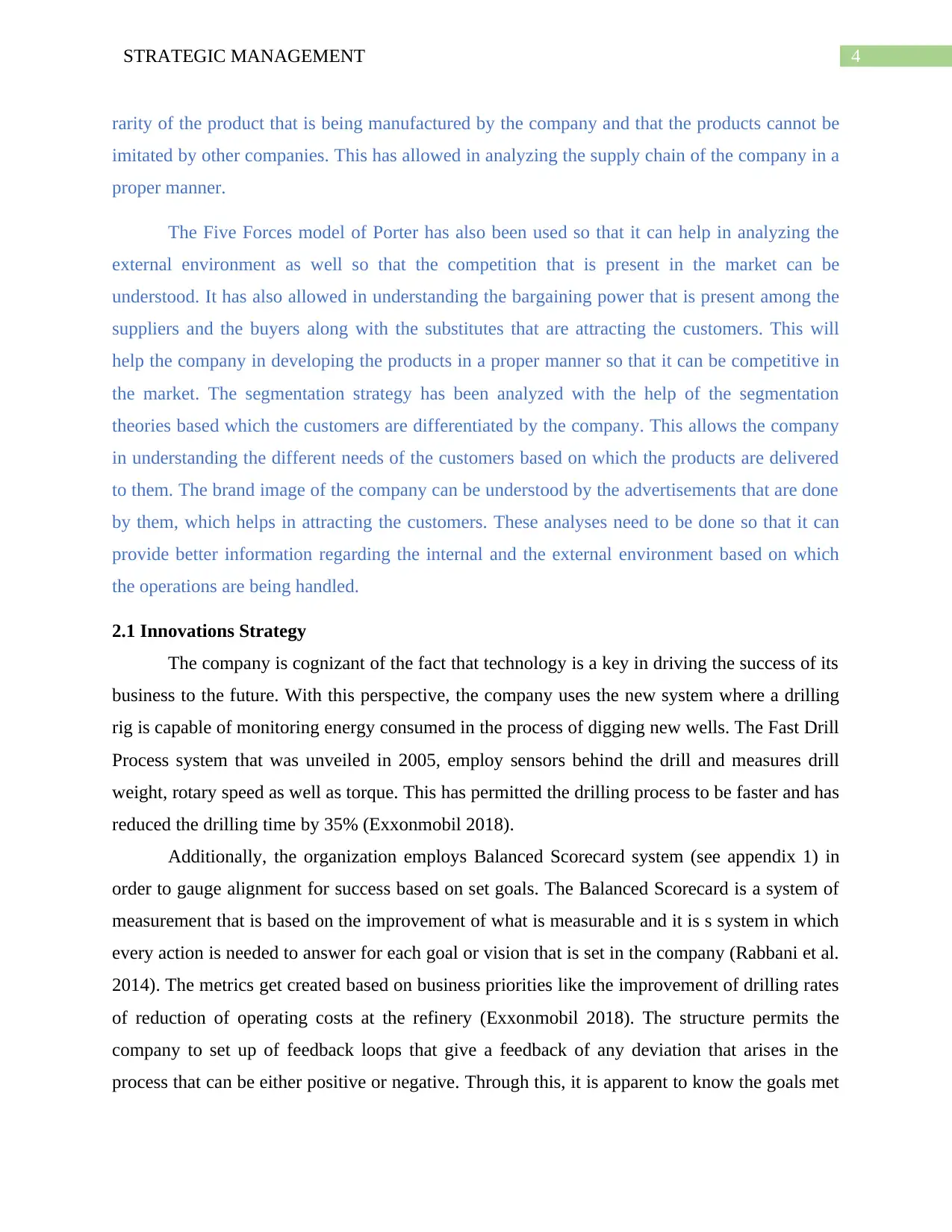
4STRATEGIC MANAGEMENT
rarity of the product that is being manufactured by the company and that the products cannot be
imitated by other companies. This has allowed in analyzing the supply chain of the company in a
proper manner.
The Five Forces model of Porter has also been used so that it can help in analyzing the
external environment as well so that the competition that is present in the market can be
understood. It has also allowed in understanding the bargaining power that is present among the
suppliers and the buyers along with the substitutes that are attracting the customers. This will
help the company in developing the products in a proper manner so that it can be competitive in
the market. The segmentation strategy has been analyzed with the help of the segmentation
theories based which the customers are differentiated by the company. This allows the company
in understanding the different needs of the customers based on which the products are delivered
to them. The brand image of the company can be understood by the advertisements that are done
by them, which helps in attracting the customers. These analyses need to be done so that it can
provide better information regarding the internal and the external environment based on which
the operations are being handled.
2.1 Innovations Strategy
The company is cognizant of the fact that technology is a key in driving the success of its
business to the future. With this perspective, the company uses the new system where a drilling
rig is capable of monitoring energy consumed in the process of digging new wells. The Fast Drill
Process system that was unveiled in 2005, employ sensors behind the drill and measures drill
weight, rotary speed as well as torque. This has permitted the drilling process to be faster and has
reduced the drilling time by 35% (Exxonmobil 2018).
Additionally, the organization employs Balanced Scorecard system (see appendix 1) in
order to gauge alignment for success based on set goals. The Balanced Scorecard is a system of
measurement that is based on the improvement of what is measurable and it is s system in which
every action is needed to answer for each goal or vision that is set in the company (Rabbani et al.
2014). The metrics get created based on business priorities like the improvement of drilling rates
of reduction of operating costs at the refinery (Exxonmobil 2018). The structure permits the
company to set up of feedback loops that give a feedback of any deviation that arises in the
process that can be either positive or negative. Through this, it is apparent to know the goals met
rarity of the product that is being manufactured by the company and that the products cannot be
imitated by other companies. This has allowed in analyzing the supply chain of the company in a
proper manner.
The Five Forces model of Porter has also been used so that it can help in analyzing the
external environment as well so that the competition that is present in the market can be
understood. It has also allowed in understanding the bargaining power that is present among the
suppliers and the buyers along with the substitutes that are attracting the customers. This will
help the company in developing the products in a proper manner so that it can be competitive in
the market. The segmentation strategy has been analyzed with the help of the segmentation
theories based which the customers are differentiated by the company. This allows the company
in understanding the different needs of the customers based on which the products are delivered
to them. The brand image of the company can be understood by the advertisements that are done
by them, which helps in attracting the customers. These analyses need to be done so that it can
provide better information regarding the internal and the external environment based on which
the operations are being handled.
2.1 Innovations Strategy
The company is cognizant of the fact that technology is a key in driving the success of its
business to the future. With this perspective, the company uses the new system where a drilling
rig is capable of monitoring energy consumed in the process of digging new wells. The Fast Drill
Process system that was unveiled in 2005, employ sensors behind the drill and measures drill
weight, rotary speed as well as torque. This has permitted the drilling process to be faster and has
reduced the drilling time by 35% (Exxonmobil 2018).
Additionally, the organization employs Balanced Scorecard system (see appendix 1) in
order to gauge alignment for success based on set goals. The Balanced Scorecard is a system of
measurement that is based on the improvement of what is measurable and it is s system in which
every action is needed to answer for each goal or vision that is set in the company (Rabbani et al.
2014). The metrics get created based on business priorities like the improvement of drilling rates
of reduction of operating costs at the refinery (Exxonmobil 2018). The structure permits the
company to set up of feedback loops that give a feedback of any deviation that arises in the
process that can be either positive or negative. Through this, it is apparent to know the goals met

5STRATEGIC MANAGEMENT
and those not met so that changes get accommodated for making up on the shortfalls experienced
and to set better priorities in use of technology (Fleuren et al. 2014).
Additionally, the organization places people in the development teams who use finished
applications. These people from various departments get send to the research laboratory where
research and innovations are undertaken so that they become part of the people in new
developments and they assist in writing codes thus ensuring that they stay on target based on
technological advancements (Friedrich von den Eichen, Freiling and Matzler 2015).
Moreover, with the advancement in technology, ExxonMobil uses 4D seismic imaging
technology in locating new sources of oil and gas. This transforms the past norms of drilling oil
and gas in places that were thought they exist and this many times resulted in many dry holes
(Naor et al. 2015). Over the years the organization has evolved technologically and at present,
the company has Center for Interactive Interpretation (Cii) in Houston where the art of seismic
imaging get done and allows the 3D projections of seismic data to be manipulated in a virtual
environment for planning (Exxonmobil 2018). Currently, ExxonMobil uses 4D with comprises
time-lapse as an additional feature of 3D technology. The technology permits company’s
geologists and engineers to monitor the changes of reservoirs and thus allow the company to drill
oil and gas in complex places which that prove difficult and increasing the rate of drilling which
is a success to ExxonMobil (Kim and Mauborgne 2014).
2.2 Supply chain management
The ExxonMobil’s success is based on the suppliers who are valued in the company’s
operation. The company has over 90,000 suppliers globally. In ensuring that there is the good
relationship, the company encourages the respect of human rights and the environment in the
process of creating opportunities for all groups comprising the underrepresented groups (Stadtler
2015).
In ensuring that there is continued the good working relationship, ExxonMobil employs
sustainable supplying (Hazen et al., 2014). The company engages in communication with
suppliers through annual meetings across nine commodity groups in order to enlighten them on
issues that touch on human rights, sustainable environment, local content and supplier delivery.
The approach is taken by the organization because it is an avenue for building strong future
collaboration and enhancing sustainable performance (Jacobs, Chase and Lummus 2014).
ExxonMobil encouraged the suppliers to be responsible for the environment as enshrined in the
and those not met so that changes get accommodated for making up on the shortfalls experienced
and to set better priorities in use of technology (Fleuren et al. 2014).
Additionally, the organization places people in the development teams who use finished
applications. These people from various departments get send to the research laboratory where
research and innovations are undertaken so that they become part of the people in new
developments and they assist in writing codes thus ensuring that they stay on target based on
technological advancements (Friedrich von den Eichen, Freiling and Matzler 2015).
Moreover, with the advancement in technology, ExxonMobil uses 4D seismic imaging
technology in locating new sources of oil and gas. This transforms the past norms of drilling oil
and gas in places that were thought they exist and this many times resulted in many dry holes
(Naor et al. 2015). Over the years the organization has evolved technologically and at present,
the company has Center for Interactive Interpretation (Cii) in Houston where the art of seismic
imaging get done and allows the 3D projections of seismic data to be manipulated in a virtual
environment for planning (Exxonmobil 2018). Currently, ExxonMobil uses 4D with comprises
time-lapse as an additional feature of 3D technology. The technology permits company’s
geologists and engineers to monitor the changes of reservoirs and thus allow the company to drill
oil and gas in complex places which that prove difficult and increasing the rate of drilling which
is a success to ExxonMobil (Kim and Mauborgne 2014).
2.2 Supply chain management
The ExxonMobil’s success is based on the suppliers who are valued in the company’s
operation. The company has over 90,000 suppliers globally. In ensuring that there is the good
relationship, the company encourages the respect of human rights and the environment in the
process of creating opportunities for all groups comprising the underrepresented groups (Stadtler
2015).
In ensuring that there is continued the good working relationship, ExxonMobil employs
sustainable supplying (Hazen et al., 2014). The company engages in communication with
suppliers through annual meetings across nine commodity groups in order to enlighten them on
issues that touch on human rights, sustainable environment, local content and supplier delivery.
The approach is taken by the organization because it is an avenue for building strong future
collaboration and enhancing sustainable performance (Jacobs, Chase and Lummus 2014).
ExxonMobil encouraged the suppliers to be responsible for the environment as enshrined in the
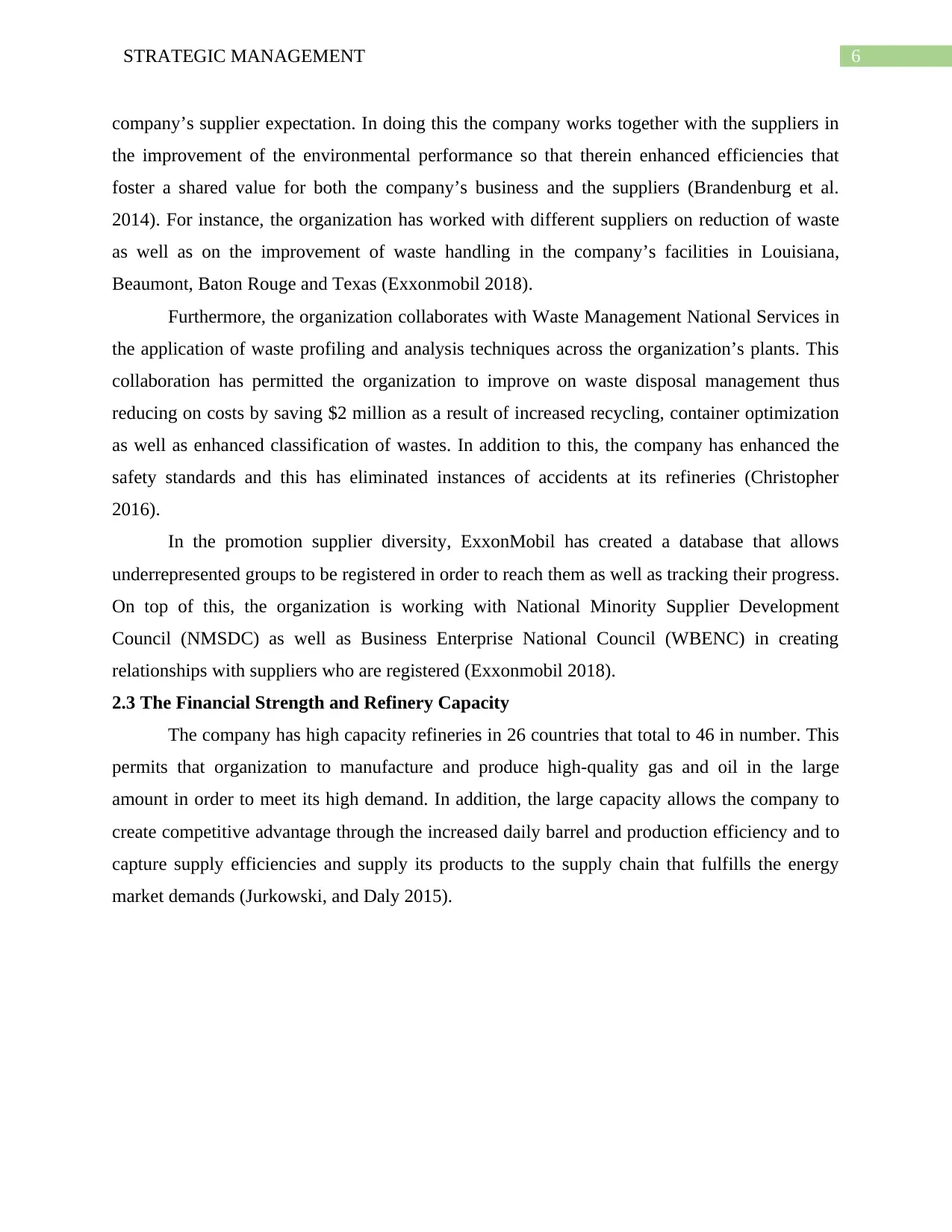
6STRATEGIC MANAGEMENT
company’s supplier expectation. In doing this the company works together with the suppliers in
the improvement of the environmental performance so that therein enhanced efficiencies that
foster a shared value for both the company’s business and the suppliers (Brandenburg et al.
2014). For instance, the organization has worked with different suppliers on reduction of waste
as well as on the improvement of waste handling in the company’s facilities in Louisiana,
Beaumont, Baton Rouge and Texas (Exxonmobil 2018).
Furthermore, the organization collaborates with Waste Management National Services in
the application of waste profiling and analysis techniques across the organization’s plants. This
collaboration has permitted the organization to improve on waste disposal management thus
reducing on costs by saving $2 million as a result of increased recycling, container optimization
as well as enhanced classification of wastes. In addition to this, the company has enhanced the
safety standards and this has eliminated instances of accidents at its refineries (Christopher
2016).
In the promotion supplier diversity, ExxonMobil has created a database that allows
underrepresented groups to be registered in order to reach them as well as tracking their progress.
On top of this, the organization is working with National Minority Supplier Development
Council (NMSDC) as well as Business Enterprise National Council (WBENC) in creating
relationships with suppliers who are registered (Exxonmobil 2018).
2.3 The Financial Strength and Refinery Capacity
The company has high capacity refineries in 26 countries that total to 46 in number. This
permits that organization to manufacture and produce high-quality gas and oil in the large
amount in order to meet its high demand. In addition, the large capacity allows the company to
create competitive advantage through the increased daily barrel and production efficiency and to
capture supply efficiencies and supply its products to the supply chain that fulfills the energy
market demands (Jurkowski, and Daly 2015).
company’s supplier expectation. In doing this the company works together with the suppliers in
the improvement of the environmental performance so that therein enhanced efficiencies that
foster a shared value for both the company’s business and the suppliers (Brandenburg et al.
2014). For instance, the organization has worked with different suppliers on reduction of waste
as well as on the improvement of waste handling in the company’s facilities in Louisiana,
Beaumont, Baton Rouge and Texas (Exxonmobil 2018).
Furthermore, the organization collaborates with Waste Management National Services in
the application of waste profiling and analysis techniques across the organization’s plants. This
collaboration has permitted the organization to improve on waste disposal management thus
reducing on costs by saving $2 million as a result of increased recycling, container optimization
as well as enhanced classification of wastes. In addition to this, the company has enhanced the
safety standards and this has eliminated instances of accidents at its refineries (Christopher
2016).
In the promotion supplier diversity, ExxonMobil has created a database that allows
underrepresented groups to be registered in order to reach them as well as tracking their progress.
On top of this, the organization is working with National Minority Supplier Development
Council (NMSDC) as well as Business Enterprise National Council (WBENC) in creating
relationships with suppliers who are registered (Exxonmobil 2018).
2.3 The Financial Strength and Refinery Capacity
The company has high capacity refineries in 26 countries that total to 46 in number. This
permits that organization to manufacture and produce high-quality gas and oil in the large
amount in order to meet its high demand. In addition, the large capacity allows the company to
create competitive advantage through the increased daily barrel and production efficiency and to
capture supply efficiencies and supply its products to the supply chain that fulfills the energy
market demands (Jurkowski, and Daly 2015).
Paraphrase This Document
Need a fresh take? Get an instant paraphrase of this document with our AI Paraphraser
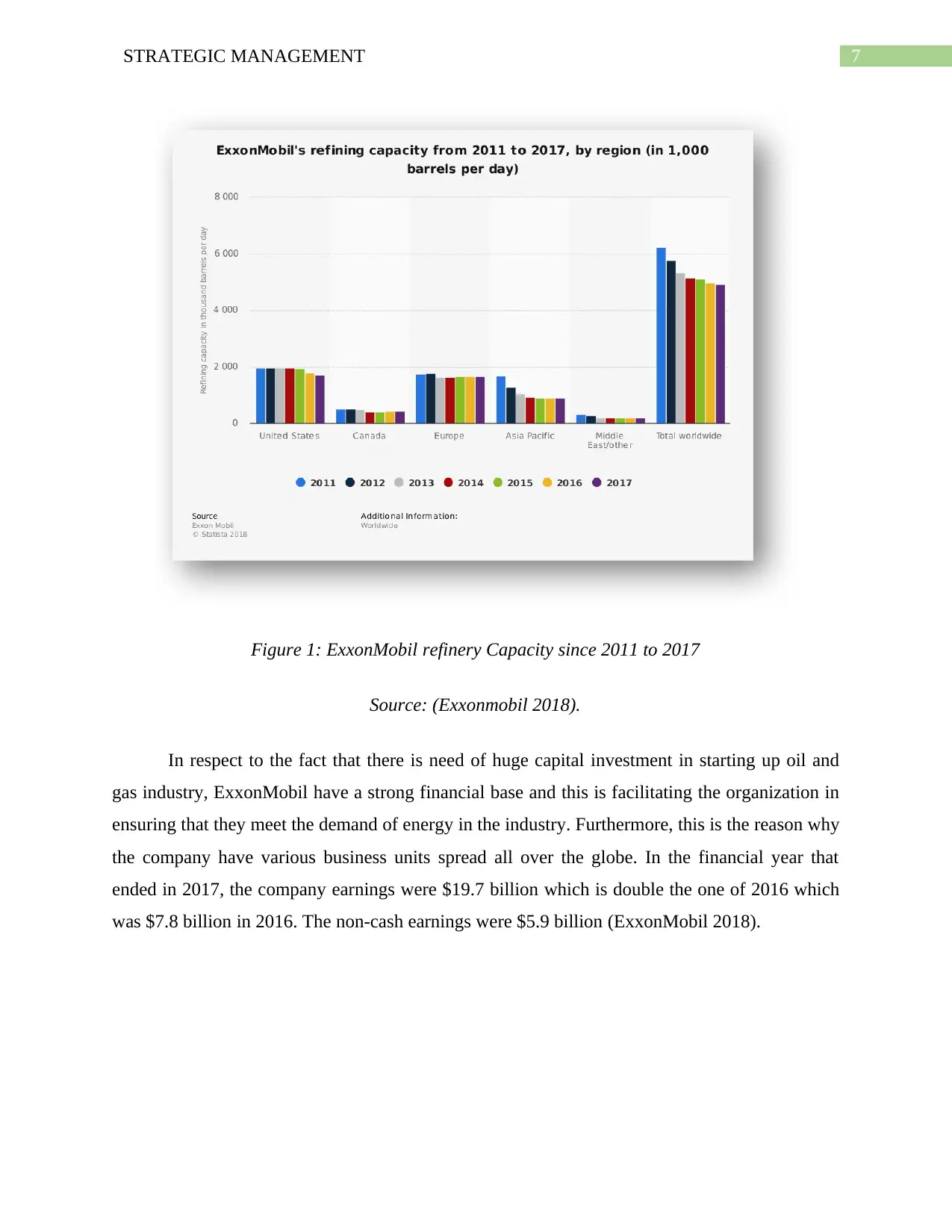
7STRATEGIC MANAGEMENT
Figure 1: ExxonMobil refinery Capacity since 2011 to 2017
Source: (Exxonmobil 2018).
In respect to the fact that there is need of huge capital investment in starting up oil and
gas industry, ExxonMobil have a strong financial base and this is facilitating the organization in
ensuring that they meet the demand of energy in the industry. Furthermore, this is the reason why
the company have various business units spread all over the globe. In the financial year that
ended in 2017, the company earnings were $19.7 billion which is double the one of 2016 which
was $7.8 billion in 2016. The non-cash earnings were $5.9 billion (ExxonMobil 2018).
Figure 1: ExxonMobil refinery Capacity since 2011 to 2017
Source: (Exxonmobil 2018).
In respect to the fact that there is need of huge capital investment in starting up oil and
gas industry, ExxonMobil have a strong financial base and this is facilitating the organization in
ensuring that they meet the demand of energy in the industry. Furthermore, this is the reason why
the company have various business units spread all over the globe. In the financial year that
ended in 2017, the company earnings were $19.7 billion which is double the one of 2016 which
was $7.8 billion in 2016. The non-cash earnings were $5.9 billion (ExxonMobil 2018).
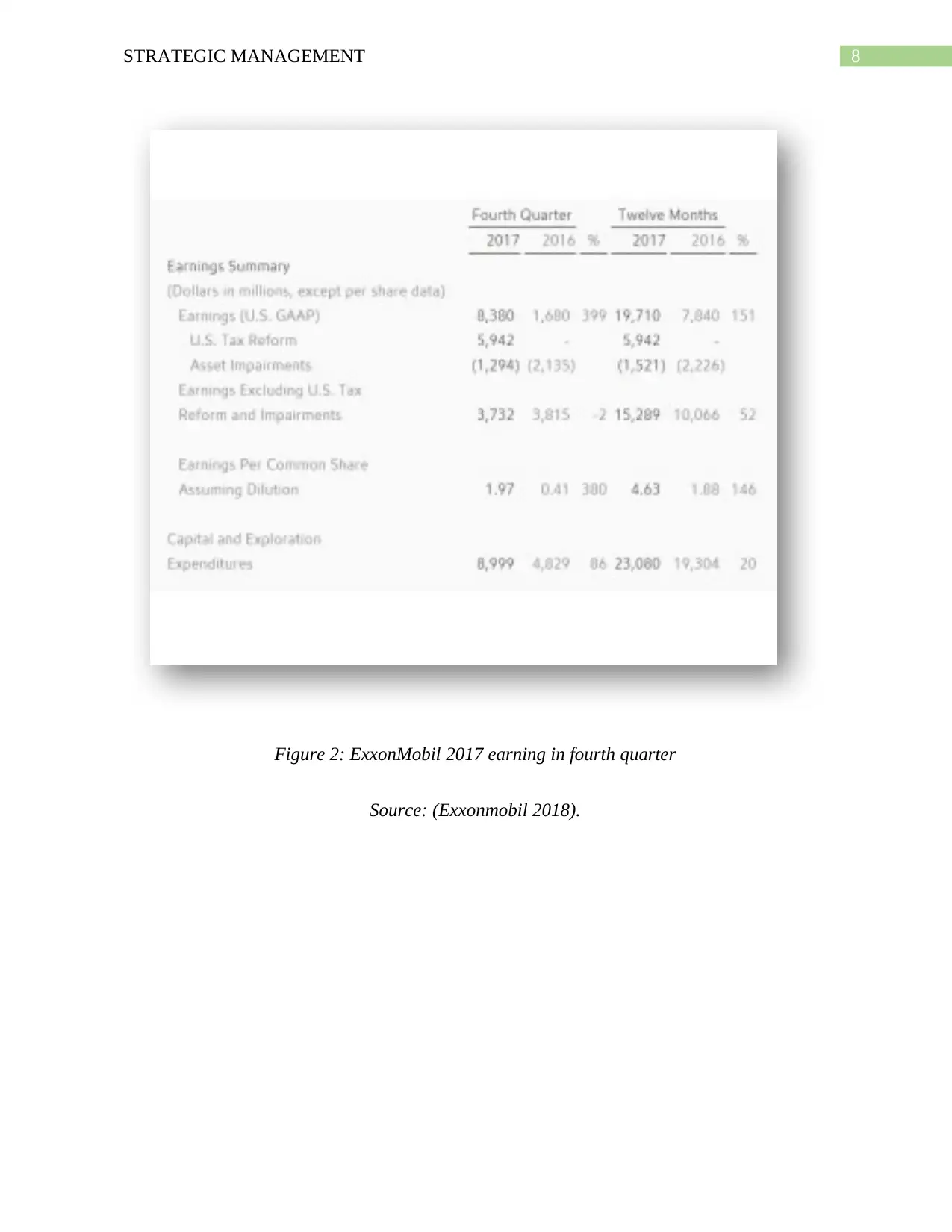
8STRATEGIC MANAGEMENT
Figure 2: ExxonMobil 2017 earning in fourth quarter
Source: (Exxonmobil 2018).
Figure 2: ExxonMobil 2017 earning in fourth quarter
Source: (Exxonmobil 2018).
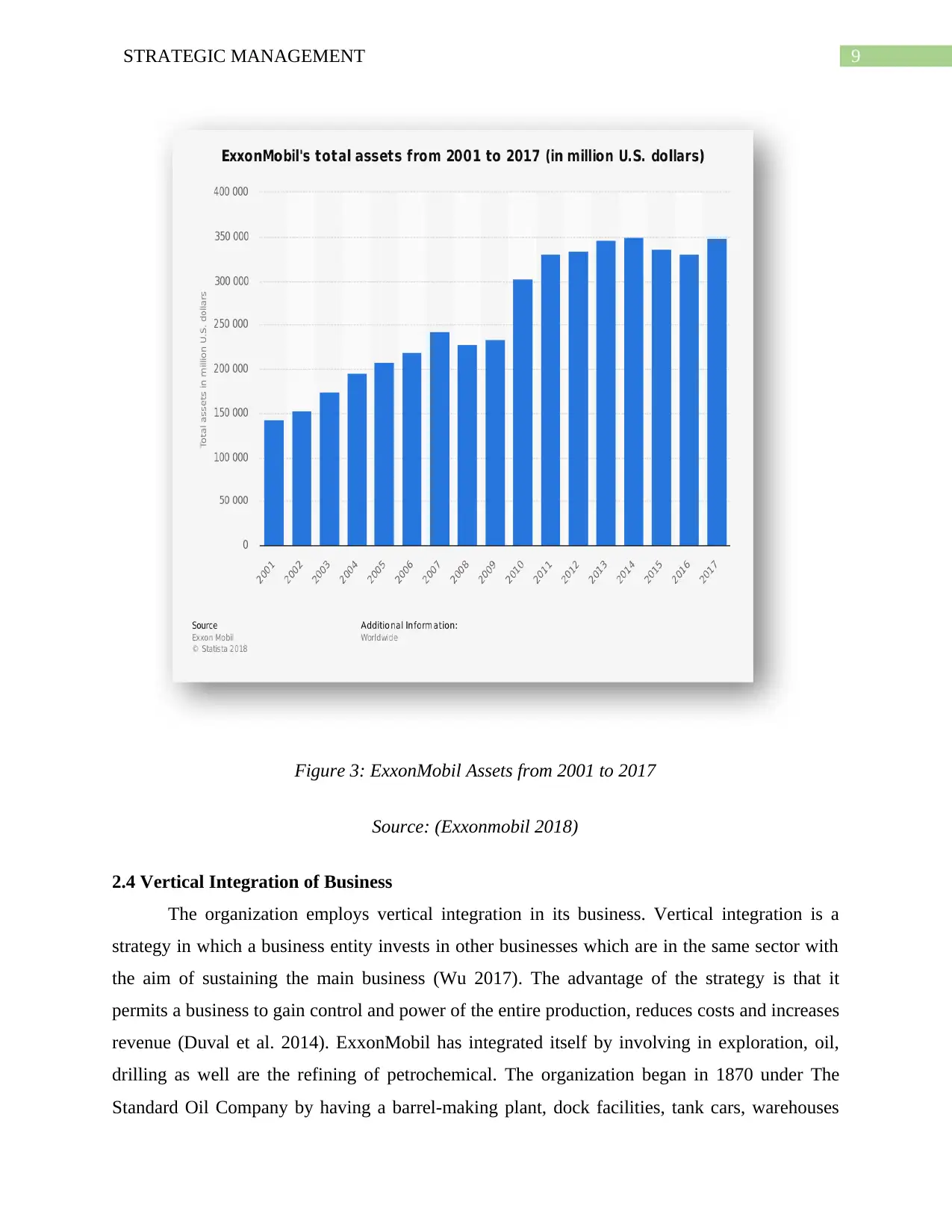
9STRATEGIC MANAGEMENT
Figure 3: ExxonMobil Assets from 2001 to 2017
Source: (Exxonmobil 2018)
2.4 Vertical Integration of Business
The organization employs vertical integration in its business. Vertical integration is a
strategy in which a business entity invests in other businesses which are in the same sector with
the aim of sustaining the main business (Wu 2017). The advantage of the strategy is that it
permits a business to gain control and power of the entire production, reduces costs and increases
revenue (Duval et al. 2014). ExxonMobil has integrated itself by involving in exploration, oil,
drilling as well are the refining of petrochemical. The organization began in 1870 under The
Standard Oil Company by having a barrel-making plant, dock facilities, tank cars, warehouses
Figure 3: ExxonMobil Assets from 2001 to 2017
Source: (Exxonmobil 2018)
2.4 Vertical Integration of Business
The organization employs vertical integration in its business. Vertical integration is a
strategy in which a business entity invests in other businesses which are in the same sector with
the aim of sustaining the main business (Wu 2017). The advantage of the strategy is that it
permits a business to gain control and power of the entire production, reduces costs and increases
revenue (Duval et al. 2014). ExxonMobil has integrated itself by involving in exploration, oil,
drilling as well are the refining of petrochemical. The organization began in 1870 under The
Standard Oil Company by having a barrel-making plant, dock facilities, tank cars, warehouses
Secure Best Marks with AI Grader
Need help grading? Try our AI Grader for instant feedback on your assignments.

10STRATEGIC MANAGEMENT
and land under in New York. Mobil in 1931 merged with Vacuum Oil Company and with
Magnolia Petroleum Company in 1959. The company in 2009 bought XTO Energy which
provided the company with about 45 trillion cubic feet of natural gas across America. Therefore
vertical integration has assisted the organization to achieve their goals and thereby capturing the
niche in the market in every sector they are venturing (Atalay, Hortacsu and Syverson 2014).
2.5 Cost Efficiency and Increase of Profits
When a business run at a very high cost the possibility of getting high returns diminishes
and in many instances leads to losses. The measures of avoiding these losses are by cutting on
costs in the business. In employing this aspect of cutting costs, ExxonMobil has remained in
profit even during the turbulence times like the prices of oil which fell in between1980 and 1990.
The organization during such occurrences reduces the operating costs. In this period, the
company reduced the costs by $1.3 billion on a yearly basis. The philosophy used by
ExxonMobil is improving efficiency, lawless, profitability and make the shareholders get profits.
For example, the organization uses a cost-effective new technology that helps in reducing GHG
emission and augmenting production.
2.6 Segmentation Strategy
In order to forge ahead of the rest in the industry, the organization is integrated into
upstream, downstream, as well as chemicals. The upstream section is tasked with the
specialization of exploring and producing crude oil and natural gas. This section has its operation
in thirty-six nations with five companies with a global perspective. The role of these
organizations is for exploration, development, production, gas and power marketing, as well as
upstream-research tasks. The portfolios of these organizations are operation in Canada, America,
Europe, Middle East, Australia, Russia, Africa, Caspian, and Asia-Pacific (Exxonmobil 2018).
The downstream section is tasked with refining, supplying, and marketing of fuels. The
focus of the company on the downstream section is to provide fuel products as well as feedstock.
The manufacturers of Exxon Mobil provide clean fuel, lubes, as well as other high-value
products. The company has 12 lubricant refineries which manufacture Exxon, Mobil, and Esso
brands of lubricants via 31 blending plants. These Exxon, Mobil, and Esso brands serve over
motorists in over 29,000 service stations. Furthermore, they provide over one million industrial
and fuel products wholesale to its customers. On the other hand, the fuels products are also given
to the aviation industry and servers over 630 airports and over 180 marine ports globally
and land under in New York. Mobil in 1931 merged with Vacuum Oil Company and with
Magnolia Petroleum Company in 1959. The company in 2009 bought XTO Energy which
provided the company with about 45 trillion cubic feet of natural gas across America. Therefore
vertical integration has assisted the organization to achieve their goals and thereby capturing the
niche in the market in every sector they are venturing (Atalay, Hortacsu and Syverson 2014).
2.5 Cost Efficiency and Increase of Profits
When a business run at a very high cost the possibility of getting high returns diminishes
and in many instances leads to losses. The measures of avoiding these losses are by cutting on
costs in the business. In employing this aspect of cutting costs, ExxonMobil has remained in
profit even during the turbulence times like the prices of oil which fell in between1980 and 1990.
The organization during such occurrences reduces the operating costs. In this period, the
company reduced the costs by $1.3 billion on a yearly basis. The philosophy used by
ExxonMobil is improving efficiency, lawless, profitability and make the shareholders get profits.
For example, the organization uses a cost-effective new technology that helps in reducing GHG
emission and augmenting production.
2.6 Segmentation Strategy
In order to forge ahead of the rest in the industry, the organization is integrated into
upstream, downstream, as well as chemicals. The upstream section is tasked with the
specialization of exploring and producing crude oil and natural gas. This section has its operation
in thirty-six nations with five companies with a global perspective. The role of these
organizations is for exploration, development, production, gas and power marketing, as well as
upstream-research tasks. The portfolios of these organizations are operation in Canada, America,
Europe, Middle East, Australia, Russia, Africa, Caspian, and Asia-Pacific (Exxonmobil 2018).
The downstream section is tasked with refining, supplying, and marketing of fuels. The
focus of the company on the downstream section is to provide fuel products as well as feedstock.
The manufacturers of Exxon Mobil provide clean fuel, lubes, as well as other high-value
products. The company has 12 lubricant refineries which manufacture Exxon, Mobil, and Esso
brands of lubricants via 31 blending plants. These Exxon, Mobil, and Esso brands serve over
motorists in over 29,000 service stations. Furthermore, they provide over one million industrial
and fuel products wholesale to its customers. On the other hand, the fuels products are also given
to the aviation industry and servers over 630 airports and over 180 marine ports globally
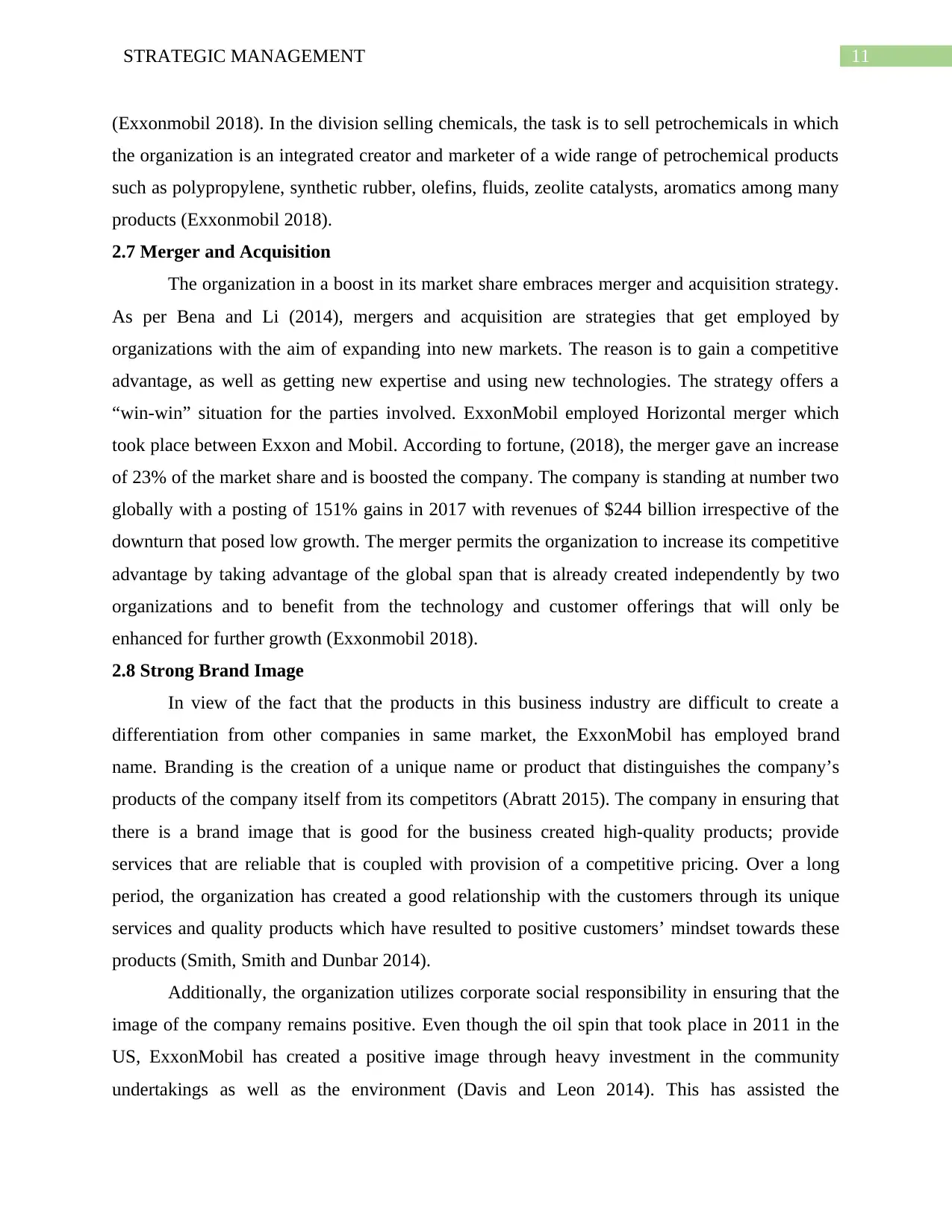
11STRATEGIC MANAGEMENT
(Exxonmobil 2018). In the division selling chemicals, the task is to sell petrochemicals in which
the organization is an integrated creator and marketer of a wide range of petrochemical products
such as polypropylene, synthetic rubber, olefins, fluids, zeolite catalysts, aromatics among many
products (Exxonmobil 2018).
2.7 Merger and Acquisition
The organization in a boost in its market share embraces merger and acquisition strategy.
As per Bena and Li (2014), mergers and acquisition are strategies that get employed by
organizations with the aim of expanding into new markets. The reason is to gain a competitive
advantage, as well as getting new expertise and using new technologies. The strategy offers a
“win-win” situation for the parties involved. ExxonMobil employed Horizontal merger which
took place between Exxon and Mobil. According to fortune, (2018), the merger gave an increase
of 23% of the market share and is boosted the company. The company is standing at number two
globally with a posting of 151% gains in 2017 with revenues of $244 billion irrespective of the
downturn that posed low growth. The merger permits the organization to increase its competitive
advantage by taking advantage of the global span that is already created independently by two
organizations and to benefit from the technology and customer offerings that will only be
enhanced for further growth (Exxonmobil 2018).
2.8 Strong Brand Image
In view of the fact that the products in this business industry are difficult to create a
differentiation from other companies in same market, the ExxonMobil has employed brand
name. Branding is the creation of a unique name or product that distinguishes the company’s
products of the company itself from its competitors (Abratt 2015). The company in ensuring that
there is a brand image that is good for the business created high-quality products; provide
services that are reliable that is coupled with provision of a competitive pricing. Over a long
period, the organization has created a good relationship with the customers through its unique
services and quality products which have resulted to positive customers’ mindset towards these
products (Smith, Smith and Dunbar 2014).
Additionally, the organization utilizes corporate social responsibility in ensuring that the
image of the company remains positive. Even though the oil spin that took place in 2011 in the
US, ExxonMobil has created a positive image through heavy investment in the community
undertakings as well as the environment (Davis and Leon 2014). This has assisted the
(Exxonmobil 2018). In the division selling chemicals, the task is to sell petrochemicals in which
the organization is an integrated creator and marketer of a wide range of petrochemical products
such as polypropylene, synthetic rubber, olefins, fluids, zeolite catalysts, aromatics among many
products (Exxonmobil 2018).
2.7 Merger and Acquisition
The organization in a boost in its market share embraces merger and acquisition strategy.
As per Bena and Li (2014), mergers and acquisition are strategies that get employed by
organizations with the aim of expanding into new markets. The reason is to gain a competitive
advantage, as well as getting new expertise and using new technologies. The strategy offers a
“win-win” situation for the parties involved. ExxonMobil employed Horizontal merger which
took place between Exxon and Mobil. According to fortune, (2018), the merger gave an increase
of 23% of the market share and is boosted the company. The company is standing at number two
globally with a posting of 151% gains in 2017 with revenues of $244 billion irrespective of the
downturn that posed low growth. The merger permits the organization to increase its competitive
advantage by taking advantage of the global span that is already created independently by two
organizations and to benefit from the technology and customer offerings that will only be
enhanced for further growth (Exxonmobil 2018).
2.8 Strong Brand Image
In view of the fact that the products in this business industry are difficult to create a
differentiation from other companies in same market, the ExxonMobil has employed brand
name. Branding is the creation of a unique name or product that distinguishes the company’s
products of the company itself from its competitors (Abratt 2015). The company in ensuring that
there is a brand image that is good for the business created high-quality products; provide
services that are reliable that is coupled with provision of a competitive pricing. Over a long
period, the organization has created a good relationship with the customers through its unique
services and quality products which have resulted to positive customers’ mindset towards these
products (Smith, Smith and Dunbar 2014).
Additionally, the organization utilizes corporate social responsibility in ensuring that the
image of the company remains positive. Even though the oil spin that took place in 2011 in the
US, ExxonMobil has created a positive image through heavy investment in the community
undertakings as well as the environment (Davis and Leon 2014). This has assisted the
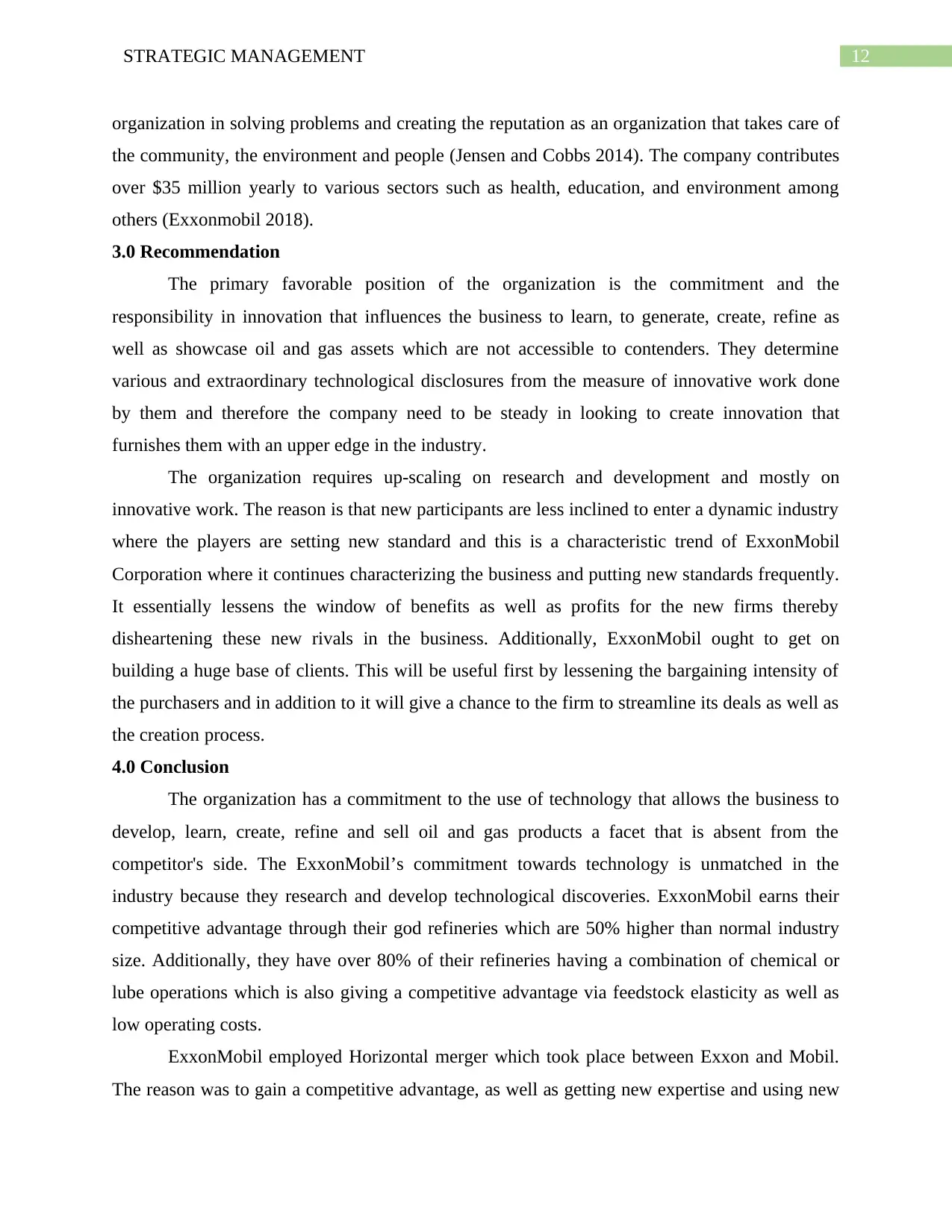
12STRATEGIC MANAGEMENT
organization in solving problems and creating the reputation as an organization that takes care of
the community, the environment and people (Jensen and Cobbs 2014). The company contributes
over $35 million yearly to various sectors such as health, education, and environment among
others (Exxonmobil 2018).
3.0 Recommendation
The primary favorable position of the organization is the commitment and the
responsibility in innovation that influences the business to learn, to generate, create, refine as
well as showcase oil and gas assets which are not accessible to contenders. They determine
various and extraordinary technological disclosures from the measure of innovative work done
by them and therefore the company need to be steady in looking to create innovation that
furnishes them with an upper edge in the industry.
The organization requires up-scaling on research and development and mostly on
innovative work. The reason is that new participants are less inclined to enter a dynamic industry
where the players are setting new standard and this is a characteristic trend of ExxonMobil
Corporation where it continues characterizing the business and putting new standards frequently.
It essentially lessens the window of benefits as well as profits for the new firms thereby
disheartening these new rivals in the business. Additionally, ExxonMobil ought to get on
building a huge base of clients. This will be useful first by lessening the bargaining intensity of
the purchasers and in addition to it will give a chance to the firm to streamline its deals as well as
the creation process.
4.0 Conclusion
The organization has a commitment to the use of technology that allows the business to
develop, learn, create, refine and sell oil and gas products a facet that is absent from the
competitor's side. The ExxonMobil’s commitment towards technology is unmatched in the
industry because they research and develop technological discoveries. ExxonMobil earns their
competitive advantage through their god refineries which are 50% higher than normal industry
size. Additionally, they have over 80% of their refineries having a combination of chemical or
lube operations which is also giving a competitive advantage via feedstock elasticity as well as
low operating costs.
ExxonMobil employed Horizontal merger which took place between Exxon and Mobil.
The reason was to gain a competitive advantage, as well as getting new expertise and using new
organization in solving problems and creating the reputation as an organization that takes care of
the community, the environment and people (Jensen and Cobbs 2014). The company contributes
over $35 million yearly to various sectors such as health, education, and environment among
others (Exxonmobil 2018).
3.0 Recommendation
The primary favorable position of the organization is the commitment and the
responsibility in innovation that influences the business to learn, to generate, create, refine as
well as showcase oil and gas assets which are not accessible to contenders. They determine
various and extraordinary technological disclosures from the measure of innovative work done
by them and therefore the company need to be steady in looking to create innovation that
furnishes them with an upper edge in the industry.
The organization requires up-scaling on research and development and mostly on
innovative work. The reason is that new participants are less inclined to enter a dynamic industry
where the players are setting new standard and this is a characteristic trend of ExxonMobil
Corporation where it continues characterizing the business and putting new standards frequently.
It essentially lessens the window of benefits as well as profits for the new firms thereby
disheartening these new rivals in the business. Additionally, ExxonMobil ought to get on
building a huge base of clients. This will be useful first by lessening the bargaining intensity of
the purchasers and in addition to it will give a chance to the firm to streamline its deals as well as
the creation process.
4.0 Conclusion
The organization has a commitment to the use of technology that allows the business to
develop, learn, create, refine and sell oil and gas products a facet that is absent from the
competitor's side. The ExxonMobil’s commitment towards technology is unmatched in the
industry because they research and develop technological discoveries. ExxonMobil earns their
competitive advantage through their god refineries which are 50% higher than normal industry
size. Additionally, they have over 80% of their refineries having a combination of chemical or
lube operations which is also giving a competitive advantage via feedstock elasticity as well as
low operating costs.
ExxonMobil employed Horizontal merger which took place between Exxon and Mobil.
The reason was to gain a competitive advantage, as well as getting new expertise and using new
Paraphrase This Document
Need a fresh take? Get an instant paraphrase of this document with our AI Paraphraser
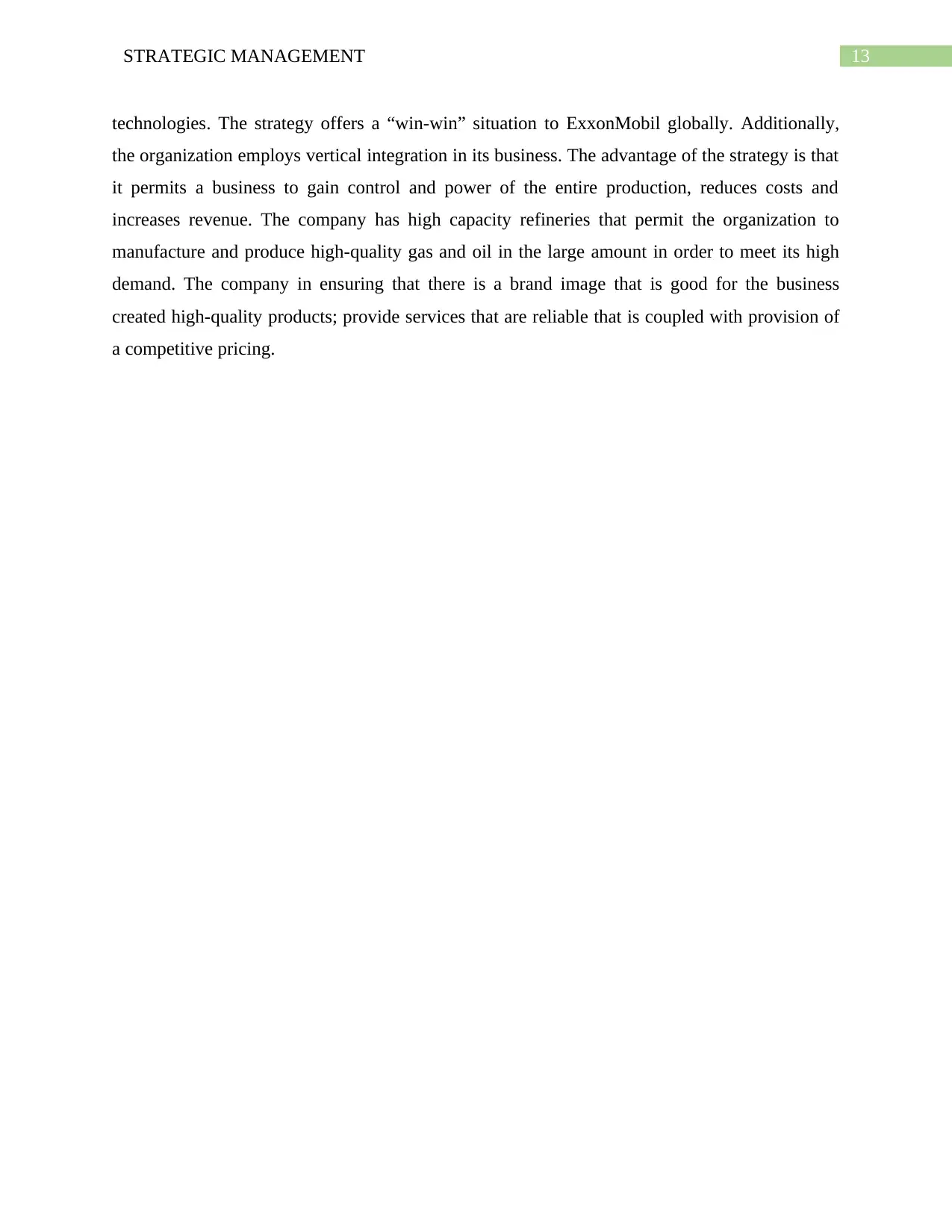
13STRATEGIC MANAGEMENT
technologies. The strategy offers a “win-win” situation to ExxonMobil globally. Additionally,
the organization employs vertical integration in its business. The advantage of the strategy is that
it permits a business to gain control and power of the entire production, reduces costs and
increases revenue. The company has high capacity refineries that permit the organization to
manufacture and produce high-quality gas and oil in the large amount in order to meet its high
demand. The company in ensuring that there is a brand image that is good for the business
created high-quality products; provide services that are reliable that is coupled with provision of
a competitive pricing.
technologies. The strategy offers a “win-win” situation to ExxonMobil globally. Additionally,
the organization employs vertical integration in its business. The advantage of the strategy is that
it permits a business to gain control and power of the entire production, reduces costs and
increases revenue. The company has high capacity refineries that permit the organization to
manufacture and produce high-quality gas and oil in the large amount in order to meet its high
demand. The company in ensuring that there is a brand image that is good for the business
created high-quality products; provide services that are reliable that is coupled with provision of
a competitive pricing.
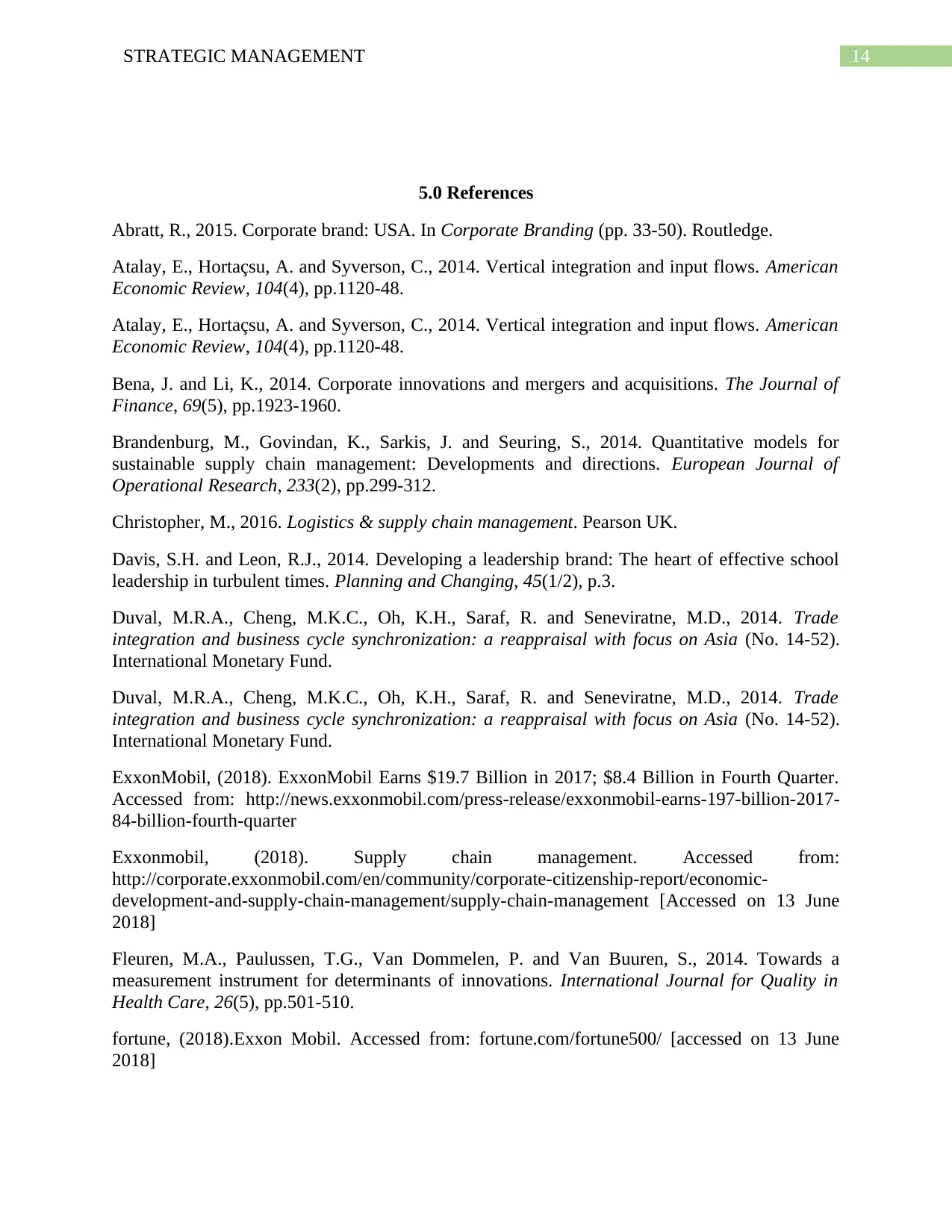
14STRATEGIC MANAGEMENT
5.0 References
Abratt, R., 2015. Corporate brand: USA. In Corporate Branding (pp. 33-50). Routledge.
Atalay, E., Hortaçsu, A. and Syverson, C., 2014. Vertical integration and input flows. American
Economic Review, 104(4), pp.1120-48.
Atalay, E., Hortaçsu, A. and Syverson, C., 2014. Vertical integration and input flows. American
Economic Review, 104(4), pp.1120-48.
Bena, J. and Li, K., 2014. Corporate innovations and mergers and acquisitions. The Journal of
Finance, 69(5), pp.1923-1960.
Brandenburg, M., Govindan, K., Sarkis, J. and Seuring, S., 2014. Quantitative models for
sustainable supply chain management: Developments and directions. European Journal of
Operational Research, 233(2), pp.299-312.
Christopher, M., 2016. Logistics & supply chain management. Pearson UK.
Davis, S.H. and Leon, R.J., 2014. Developing a leadership brand: The heart of effective school
leadership in turbulent times. Planning and Changing, 45(1/2), p.3.
Duval, M.R.A., Cheng, M.K.C., Oh, K.H., Saraf, R. and Seneviratne, M.D., 2014. Trade
integration and business cycle synchronization: a reappraisal with focus on Asia (No. 14-52).
International Monetary Fund.
Duval, M.R.A., Cheng, M.K.C., Oh, K.H., Saraf, R. and Seneviratne, M.D., 2014. Trade
integration and business cycle synchronization: a reappraisal with focus on Asia (No. 14-52).
International Monetary Fund.
ExxonMobil, (2018). ExxonMobil Earns $19.7 Billion in 2017; $8.4 Billion in Fourth Quarter.
Accessed from: http://news.exxonmobil.com/press-release/exxonmobil-earns-197-billion-2017-
84-billion-fourth-quarter
Exxonmobil, (2018). Supply chain management. Accessed from:
http://corporate.exxonmobil.com/en/community/corporate-citizenship-report/economic-
development-and-supply-chain-management/supply-chain-management [Accessed on 13 June
2018]
Fleuren, M.A., Paulussen, T.G., Van Dommelen, P. and Van Buuren, S., 2014. Towards a
measurement instrument for determinants of innovations. International Journal for Quality in
Health Care, 26(5), pp.501-510.
fortune, (2018).Exxon Mobil. Accessed from: fortune.com/fortune500/ [accessed on 13 June
2018]
5.0 References
Abratt, R., 2015. Corporate brand: USA. In Corporate Branding (pp. 33-50). Routledge.
Atalay, E., Hortaçsu, A. and Syverson, C., 2014. Vertical integration and input flows. American
Economic Review, 104(4), pp.1120-48.
Atalay, E., Hortaçsu, A. and Syverson, C., 2014. Vertical integration and input flows. American
Economic Review, 104(4), pp.1120-48.
Bena, J. and Li, K., 2014. Corporate innovations and mergers and acquisitions. The Journal of
Finance, 69(5), pp.1923-1960.
Brandenburg, M., Govindan, K., Sarkis, J. and Seuring, S., 2014. Quantitative models for
sustainable supply chain management: Developments and directions. European Journal of
Operational Research, 233(2), pp.299-312.
Christopher, M., 2016. Logistics & supply chain management. Pearson UK.
Davis, S.H. and Leon, R.J., 2014. Developing a leadership brand: The heart of effective school
leadership in turbulent times. Planning and Changing, 45(1/2), p.3.
Duval, M.R.A., Cheng, M.K.C., Oh, K.H., Saraf, R. and Seneviratne, M.D., 2014. Trade
integration and business cycle synchronization: a reappraisal with focus on Asia (No. 14-52).
International Monetary Fund.
Duval, M.R.A., Cheng, M.K.C., Oh, K.H., Saraf, R. and Seneviratne, M.D., 2014. Trade
integration and business cycle synchronization: a reappraisal with focus on Asia (No. 14-52).
International Monetary Fund.
ExxonMobil, (2018). ExxonMobil Earns $19.7 Billion in 2017; $8.4 Billion in Fourth Quarter.
Accessed from: http://news.exxonmobil.com/press-release/exxonmobil-earns-197-billion-2017-
84-billion-fourth-quarter
Exxonmobil, (2018). Supply chain management. Accessed from:
http://corporate.exxonmobil.com/en/community/corporate-citizenship-report/economic-
development-and-supply-chain-management/supply-chain-management [Accessed on 13 June
2018]
Fleuren, M.A., Paulussen, T.G., Van Dommelen, P. and Van Buuren, S., 2014. Towards a
measurement instrument for determinants of innovations. International Journal for Quality in
Health Care, 26(5), pp.501-510.
fortune, (2018).Exxon Mobil. Accessed from: fortune.com/fortune500/ [accessed on 13 June
2018]

15STRATEGIC MANAGEMENT
Friedrich von den Eichen, S., Freiling, J. and Matzler, K., 2015. Why business model
innovations fail. Journal of Business Strategy, 36(6), pp.29-38.
Hazen, B.T., Boone, C.A., Ezell, J.D. and Jones-Farmer, L.A., 2014. Data quality for data
science, predictive analytics, and big data in supply chain management: An introduction to the
problem and suggestions for research and applications. International Journal of Production
Economics, 154, pp.72-80.
Jacobs, F.R., Chase, R.B. and Lummus, R.R., 2014. Operations and supply chain management
(pp. 533-535). New York, NY: McGraw-Hill/Irwin.
Jensen, J.A. and Cobbs, J.B., 2014. Predicting return on investment in sport sponsorship:
Modeling brand exposure, price, and ROI in Formula One automotive competition. Journal of
Advertising Research, 54(4), pp.435-447.
Jurkowski, J.K. and Daly, D.D., 2015. Liquidity and solvency financial analysis of oil companies
in bric countries. International Journal of Arts and Commerce, 4(1), p.15.
Kim, W.C. and Mauborgne, R.A., 2014. Blue ocean strategy, expanded edition: How to create
uncontested market space and make the competition irrelevant. Harvard business review Press.
Monczka, R.M., Handfield, R.B., Giunipero, L.C. and Patterson, J.L., 2015. Purchasing and
supply chain management. Cengage Learning.
Naor, M., Bernardes, E.S., Druehl, C.T. and Shiftan, Y., 2015. Overcoming barriers to adoption
of environmentally-friendly innovations through design and strategy: learning from the failure of
an electric vehicle infrastructure firm. International Journal of Operations & Production
Management, 35(1), pp.26-59.
Rabbani, A., Zamani, M., Yazdani-Chamzini, A. and Zavadskas, E.K., 2014. Proposing a new
integrated model based on sustainability balanced scorecard (SBSC) and MCDM approaches by
using linguistic variables for the performance evaluation of oil producing companies. Expert
Systems with Applications, 41(16), pp.7316-7327.
Smith, K.T., Smith, L.M. and Dunbar, S., 2014. Using corporate advertising to improve public
perception of energy companies. Journal of Strategic Marketing, 22(4), pp.347-356.
Stadtler, H., 2015. Supply chain management: An overview. In Supply chain management and
advanced planning (pp. 3-28). Springer, Berlin, Heidelberg.
Wu, C., 2017. Strategic aspects of oligopolistic vertical integration. Elsevier.
Friedrich von den Eichen, S., Freiling, J. and Matzler, K., 2015. Why business model
innovations fail. Journal of Business Strategy, 36(6), pp.29-38.
Hazen, B.T., Boone, C.A., Ezell, J.D. and Jones-Farmer, L.A., 2014. Data quality for data
science, predictive analytics, and big data in supply chain management: An introduction to the
problem and suggestions for research and applications. International Journal of Production
Economics, 154, pp.72-80.
Jacobs, F.R., Chase, R.B. and Lummus, R.R., 2014. Operations and supply chain management
(pp. 533-535). New York, NY: McGraw-Hill/Irwin.
Jensen, J.A. and Cobbs, J.B., 2014. Predicting return on investment in sport sponsorship:
Modeling brand exposure, price, and ROI in Formula One automotive competition. Journal of
Advertising Research, 54(4), pp.435-447.
Jurkowski, J.K. and Daly, D.D., 2015. Liquidity and solvency financial analysis of oil companies
in bric countries. International Journal of Arts and Commerce, 4(1), p.15.
Kim, W.C. and Mauborgne, R.A., 2014. Blue ocean strategy, expanded edition: How to create
uncontested market space and make the competition irrelevant. Harvard business review Press.
Monczka, R.M., Handfield, R.B., Giunipero, L.C. and Patterson, J.L., 2015. Purchasing and
supply chain management. Cengage Learning.
Naor, M., Bernardes, E.S., Druehl, C.T. and Shiftan, Y., 2015. Overcoming barriers to adoption
of environmentally-friendly innovations through design and strategy: learning from the failure of
an electric vehicle infrastructure firm. International Journal of Operations & Production
Management, 35(1), pp.26-59.
Rabbani, A., Zamani, M., Yazdani-Chamzini, A. and Zavadskas, E.K., 2014. Proposing a new
integrated model based on sustainability balanced scorecard (SBSC) and MCDM approaches by
using linguistic variables for the performance evaluation of oil producing companies. Expert
Systems with Applications, 41(16), pp.7316-7327.
Smith, K.T., Smith, L.M. and Dunbar, S., 2014. Using corporate advertising to improve public
perception of energy companies. Journal of Strategic Marketing, 22(4), pp.347-356.
Stadtler, H., 2015. Supply chain management: An overview. In Supply chain management and
advanced planning (pp. 3-28). Springer, Berlin, Heidelberg.
Wu, C., 2017. Strategic aspects of oligopolistic vertical integration. Elsevier.
Secure Best Marks with AI Grader
Need help grading? Try our AI Grader for instant feedback on your assignments.
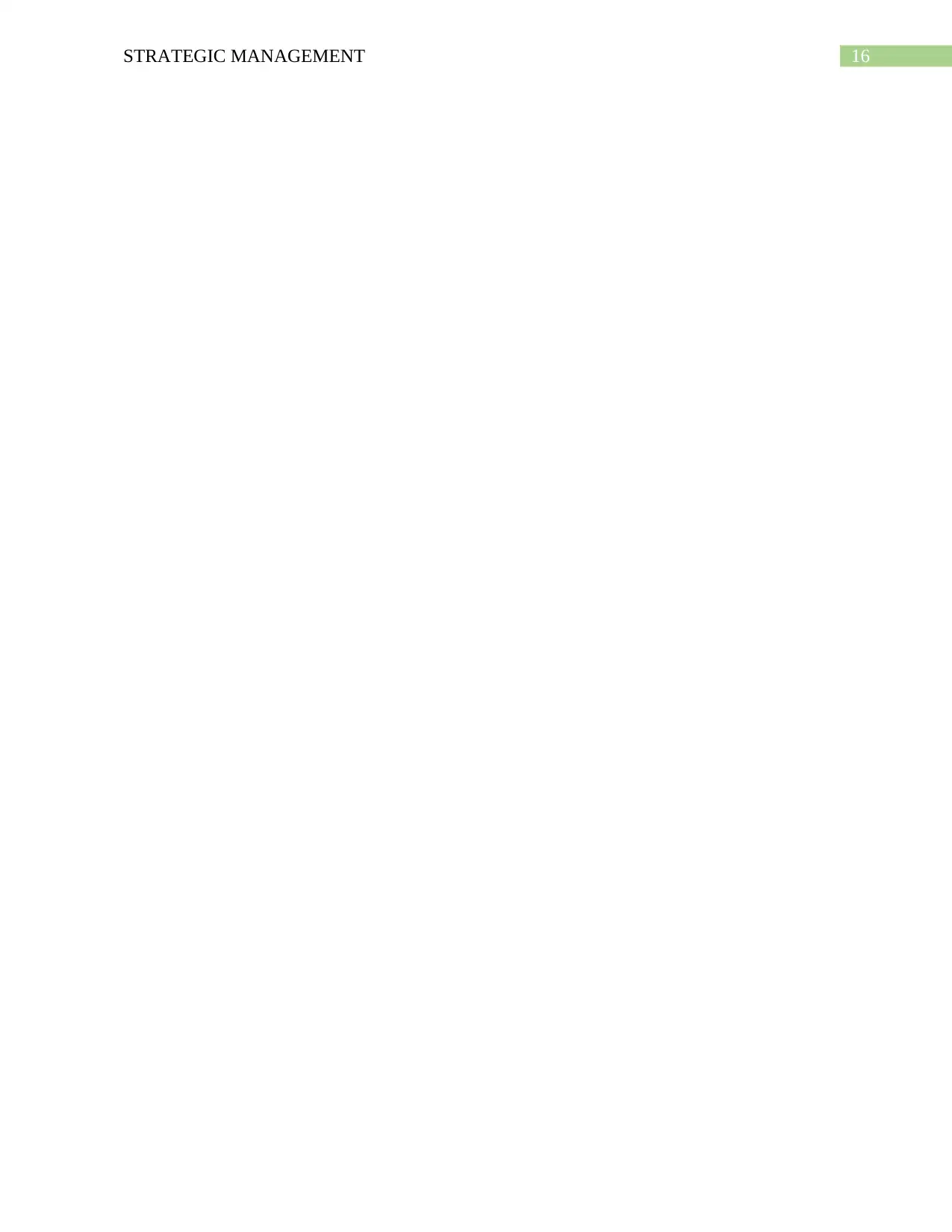
16STRATEGIC MANAGEMENT
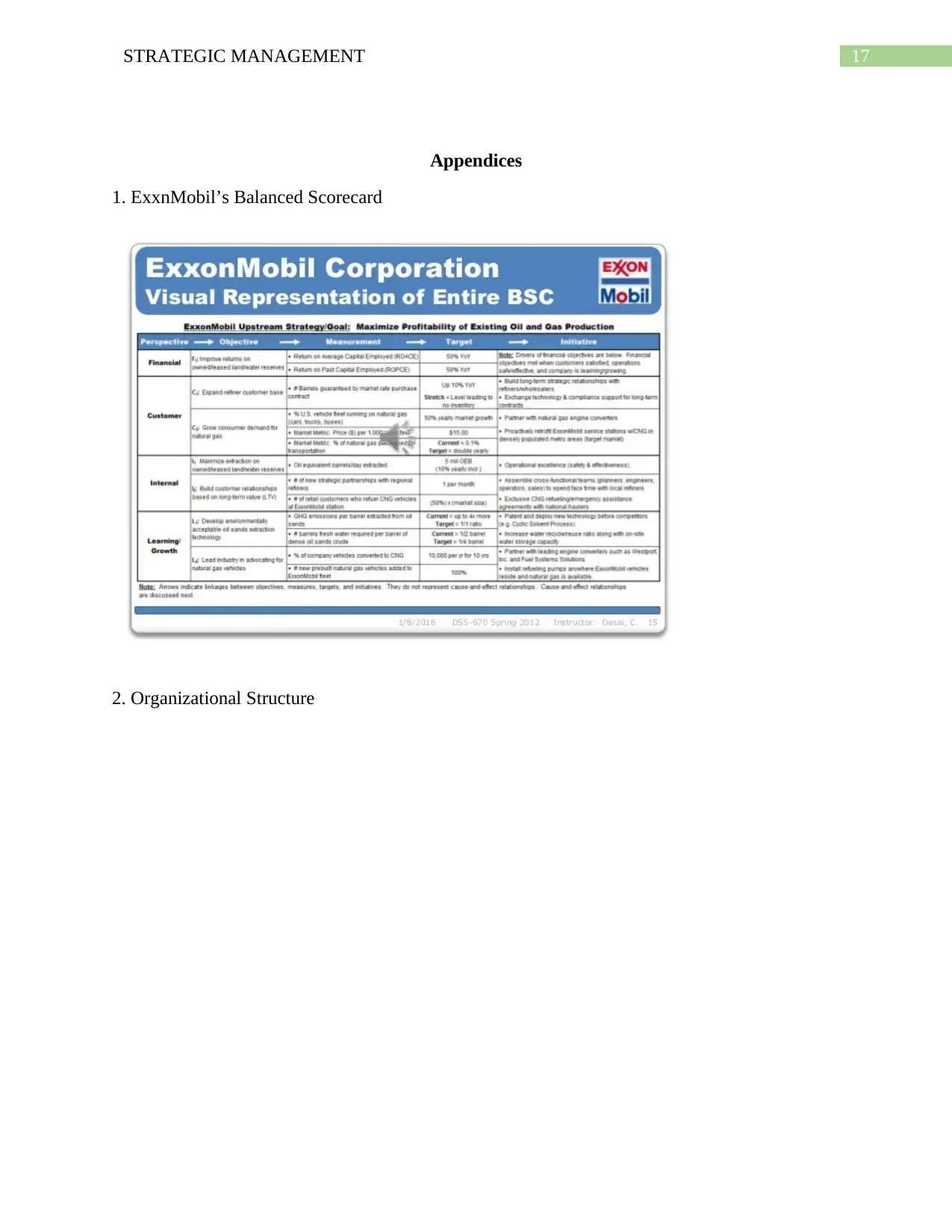
17STRATEGIC MANAGEMENT
Appendices
1. ExxnMobil’s Balanced Scorecard
2. Organizational Structure
Appendices
1. ExxnMobil’s Balanced Scorecard
2. Organizational Structure

18STRATEGIC MANAGEMENT
1 out of 19
Related Documents
Your All-in-One AI-Powered Toolkit for Academic Success.
+13062052269
info@desklib.com
Available 24*7 on WhatsApp / Email
![[object Object]](/_next/static/media/star-bottom.7253800d.svg)
Unlock your academic potential
© 2024 | Zucol Services PVT LTD | All rights reserved.





